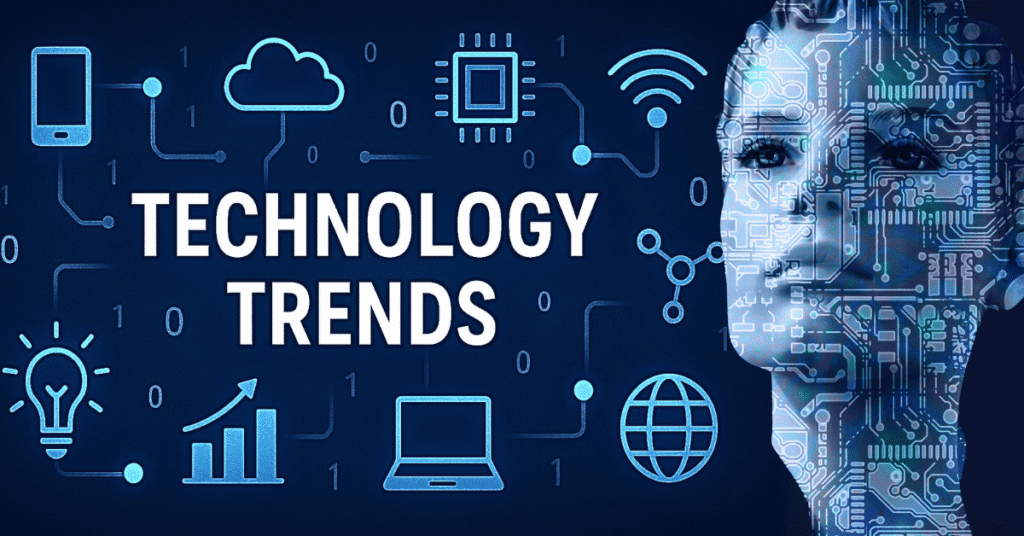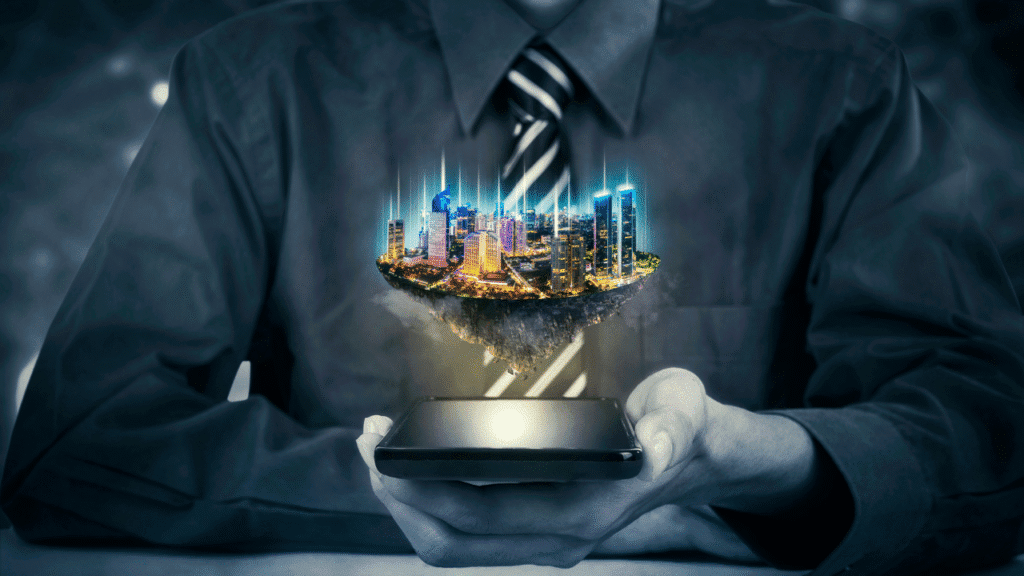Introduction
Technology trends are the roadmap to the future—guiding innovation, reshaping industries, and transforming the way we live, work, and connect. From one perspective, the pace of technological change is far too fast for businesses, developers, and society, in general, to adjust themselves in time to track changes in technological developments for competitive and informative purposes.
Therefore, this guide aims to inform readers about the important and major technological trends that shape our lives. It explains how these trends impact entire industries, forecast future developments, and how individuals can benefit from emerging trends in their personal and professional lives.
AI and ML are the two most uttered words in technology rhetoric. Yet they articulate so much more; they are truly about assistance—from e-commerce to wellness and everything in between.
Some present-day examples of AI are:
- Chatbots for customer service
- Netflix and Amazon recommendations based on user preferences
- Predictive Text in Gmail and smartphones
Goes beyond defining magic; others include updates made by ML on data.
Internet of Things
Great and wide is the Internet of Things. Mostly, it means all connected devices in intercommunicating networks collect and transmit reference data. Some collections of this trend include smart homes, fitness trackers, and connected cars.
Examples of IoT in business:
- Supply chain monitoring
- Predictive analytics
- Smart Manufacturing
- Remote healthcare
5G Connectivity
The enabler for the IoT is the arrival of 5G; this is an apotheosis for a reliable and swift communication system among all devices.
- 5G Connection and High
- 5G technology birthed connectivity.
- Low latency
- Giga bps download speed
- Real-time responsiveness
This prophecy turned into being for smart city applications for augmented reality, which would be relevant in parallel with the growing industry of autonomous vehicle technology.
Cybersecurity and Zero Trust Civilization
Cybersecurity is a deep necessity when data is exploding; thus, expect threats from ransomware, phishing, and data breaches to zero-trust security models.
Big innovations in cybersecurity are listed as:
- AI-driven threat detection
- Biometric authentication
- End-to-end encrypted communication
- Decentralized identity systems
Technical advancements keep cybersecurity in page headlines; globally, expenditures on cybersecurity are projected to exceed $250 billion by 2026.
Blockchain and Decentralized Systems
Initially designed for cryptocurrency, primarily Bitcoin, blockchain has advanced from being a mere means of digital cash to a whole lot more in the present day. Presently, it has metamorphosed into a decentralized mechanism of keeping key records, ensuring that transparency and trust are immutable.
Other sectors that are applying blockchain technology include
- Supply chain (track the goods)
- Healthcare (medical records)
- Finance (smart contracts)
- Real estate (property transaction)
Defi and NFTs are setting forth trends for the decentralized digital economy.
Augmented and Virtual Reality (AR/VR)
AR and VR offer avenues to change how we interface with the digital world. The technological trends immerse user experience from gaming all the way through to virtual property tours.
Some of the most common usages are in:
- Training simulations in both medicine and aviation
- Virtual showrooms used in e-commerce
- AR navigation in vehicles
- VR meetings in remote workplaces
The Metaverse is bold—a hybrid shared virtual world—the place where eventually all these technologies will converge.
Cloud and Edge Computing
AWS, Google Cloud, and Azure-the biggest competitors in the market-have now been building cloud infrastructures of every kind imaginable for an organization to develop without having to rely on physical servers.
These models, together with edge computing, push everything closer to the source of data, be it the device or even the sensor, and combine with other forms of computing to meet the ever-increasing demands of modern applications.
These real-time-centric applications, therefore, fit into the cases of minimizing all their latency-best fits for autonomy-would be use cases in those from the automobile industry, industrial automation, and smart cities’ applications.
Quantum Computing
It could arguably be the main reason for quantum computing having more consciousness than its classical counterpart; greatly so, this stream of technology, once having entered its field, is professing solutions to the most unbelievably complex problems in seconds. Problems that have so easily hounded years, even gone as far as thousands, in the classical computing era.
It begs for application in the following cases:
- Drug discovery
- Climate simulation
- Financial risk analysis
- Cryptography
Without question, great publicity is drawn to efforts made by Google, IBM, and others to maintain this field well-funded to encourage breakthroughs which could unleash the extremes of mankind.
Robotic Process Automation (RPA)
RPA is best exemplified in the automation of rather rule-based, repetitive work in areas like:
- Banking (i.e., transaction processing)
- Human Resources (i.e., employee onboarding)
- IT (i.e., password reset)
So far, most people point to efficiency performance and a very significant reduction in errors associated with the manual processing of tasks adopted by RPA. It also frees human resources for a broader focus on strategic initiatives. RPA has now come to be recognized as a major building block in the transformation agenda involving digitization changes across the globe.
Sustainable Technology
From a thousand points, light illuminates the stage—sustainability is turning out to be one of those very critical pillars of innovation. Go to the actions of both organizations and governments themselves toward investments in green technology to tackle dramatic climate issues. The classical list of technologies, under which such innovations take shape, is:
- Renewable Energy Systems
- Data centers: energy efficient
- Carbon capture technology
- Electric vehicles (EVs)
The current trend is that sustainable technology should be classified by economic and ecological demands, and not so much by more ethical arguments that could haunt many generations to come.
Human Augmentation and Wearables
Human augmentation might be better defined, however, as the use of technology to augment the ability of man. That is:
- Employ exoskeletons to lift heavy things.
- A patient is interfacing with a medical application through a brain-computer interface.
- Augmented reality through the “smart” glasses and head-mounted displays.
Most would think of these devices as fairly mainstream—but it’s Apple Watches and FitBits. Health and productivity systems will potentially become more and more complexly individualized.
Digital Twins
Digital twins are a virtual representation of a physical object or system. In the digital world, digital twin technology accumulates modeling, simulation, analysis, and control activities.
- The use of digital twins in industries includes
- For the optimization of the performance of manufacturing machines.
- Construction infrastructure project visibility.
- Modeling health scenarios for patient health.
With such trends in technology come greater cost reductions indeed, but also faster and more reliable ways, hence nurturing the new and innovative.
Generative AI and Automated Content
With generative artificial intelligence tools such as ChatGPT or DALL-E, everything and anything imaginable made by humans in any form would simply change. These systems can write articles, create images, compose music, and even write source code as of today.
It would revolutionize the fields of content marketing, product development, and even game development in education.
The automation would bring to the forefront of business conscience the ethical debate on ownership and misuse, while turning the production into automatic motion and cutting costs.
Low-Code and No-Code Platforms
They allow someone to create applications and websites without knowing a word of programming that might or would have otherwise been required in the most extreme cases. With that promise, the low-code and the no-code environment becomes a democratizer of software development for everybody while speeding innovation.
Top contenders include mass production in:
- Bubble
- Webflow
- Microsoft PowerApps
Trends like that in a particular technology will, therefore, sustain momentum in the application of those tools in changing one’s organization into an agile one.
Your knowledge is right at the point it has earned up to October 2023, with dates that may vary regarding it.
These technologies are so vast as far as context is involved, such that they may find a scope of studying themselves under AI modeling, filtering, and consuming those blockchains for consumer-oriented applied technologies, especially.
Analyzing and even responding to the shifts in consumer behavior to deliver tailored offers on their consumption content, be these health plans often too generalized or those related to education and emotional behavior moods.
The use of learning pathways in edtech as strategies on how to market one’s way through the coming earthquake of predictive technology: how humans and machines interface to access goods and services.
Future Technology Trends
Most of the technologies are likely to grace the emerging disunified tomorrows will be an AI-sculpted Smart City, yet have a few sprinkles of 5G safety on top of their gloss and centricity mega-digital twin. These highly outbound inventions will converge in their new ecosystems of technologies.
Any firm that plans to shut its doors to this fast-approaching arms struggle of tech change might as well close its books. Fortunately, such learning has long been seen as a rich mine for navigating growth and prosperity.
Conclusion
By all indications, the trends that will prosper together with AI and sustainable technology are those that promote successful learning and application.
Being adaptively curious and knowledgeable will always be the best preparation for the future technical professional, business leader, and loved consumer.
FAQs about Technology Trends
Why Should One Study Technology Trends?
It keeps one competitive in business, on the cutting edge of individuals ready for their governments to the future, and enhances one’s decision-making capabilities as understanding such trends increases.
How often do technology trends change for the home?
At such speed, they almost refresh with every passing year; hence, it becomes highly important to be in collaboration with good tech information and industry news.
May These Industries Benefit Most from Technology Trends?
Most, that is, these industries, go on to healthcare, finance, manufacturing, education, and the retail industry, with peculiar benefits depending on the trend and the application.
Is It Safe to Always Keep Adopting Sudden Changes in Technology Trends?
Most of these trends seem to be bright promises. This unfortunate-looking nonconformity might as well harbor some ugly truths: bugs and exorbitant pricing, especially unregulated altogether concerning this new technology. Diligence through copious research must be injected into the schedule before and during pilot testing.
How do I keep myself updated regarding technology trends?
Read technology blogs, sign up for free webinars, take online courses in such fields, follow tech-savvy people on LinkedIn or Twitter, and join professional technology communities.



